What We Learned At Ski-Doo’s 2009 Racing School

Racing tips from Ski-Doo riders and mechanics
There’s no doubt that Ski-Doo made far ranging changes and upgrades to its second year XP chassis MX Zx 600RS. A few racers attending Ski-Doo’s ‘race school’ had tested the new sled on a wood chip track and came away impressed with the results. But the only way to find out how the new Ski-Doo truly stacks up against the Polaris IQ race sled and Arctic Cat’s Sno Pro 600 is in race conditions. Team Ski-Doo and its riders will get that chance at Spirit Mountain in Duluth, Minn., on Thanksgiving weekend for the opening round of the AMSOIL ISOC National Snocross Series.
Earlier this fall when Ski-Doo issued its press release for the 2009 MX Zx 600RS, most pundits, racing insiders and knowledgeable fans expected significant changes. In fact, the updates and design improvements were not only dramatic and extensive, but also essential so that Ski-Doo could field a more competitive stock snocrosser against rivals Polaris and Arctic Cat.
At the Ski-Doo race school held in Mounds View, Minn., on Nov. 1st, Ski-Doo competition and media relations manager Steve Cowing stated, “To say that the sled [2009 MX Zx 600 RS] has changed a lot is a big understatement.” After all Ski-Doo was compelled to take bold steps to regain competitive form after a disappointing 2007-2008 race campaign in which Ski-Doo racers didn’t win a single WPSA Pro Super Stock final.
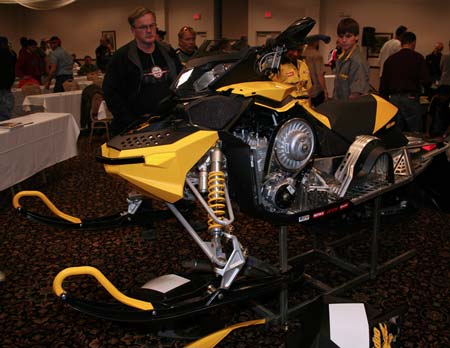 The changes to the new 2009 MX Zx 600RS are sweeping and substantial. Every major component group received significant changes. With the bodywork removed, the clutches and chassis and other components are revealed.
The changes to the new 2009 MX Zx 600RS are sweeping and substantial. Every major component group received significant changes. With the bodywork removed, the clutches and chassis and other components are revealed. Last year, Ski-Doo launched an all-new MX Zx production race sled based on the XP chassis, replacing the first-generation REV-chassis MX Zx production racers. The original REV had been wildly successful, winning races and championships in both amateur and pro ranks across the Snow Belt. While the XP-based sled offered a huge weight savings and other advances over the first-generation sled, many felt it too closely resembled Ski-Doo’s line of trail sleds. Teams experienced a myriad of problems during the course of the season, including bending chassis and suspension components, throttle cable failures, rear suspension performance problems, and other issues. But the teams, riders and engineering staff used last year to gain crucial insight into the new platform and developed improvements to remedy design weaknesses. In turn, the factory instituted changes and improvements to every major component group on the sled and targeted key areas to address the wide range of durability and performance issues.
Many Changes for 2009
At the race school, former Eagle River F-1 Champion Greg Goodwin, owner of Goodwin Performance, Ski-Doo race shop engineer Sebastien Thibault and Cowing laid out the changes. On the engine side, the new 600RS receives a new ECU (Electronic Control Unit) that features upgraded ignition and air/fuel mapping. According to Ski-Doo officials, the new mapping produces an acceleration improvement of about two sled lengths over last year’s system. When the carbs are fitted with the designated snocross or cross country jets, the ECU automatically adjusts the air/fuel mixture to the conditions, so racers don’t need to spend time jetting at the track.
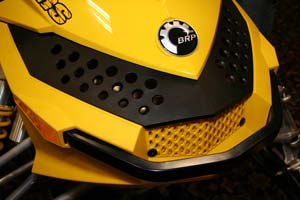 The new nose cone air intake features a new screen and filter element so a steady supply air reaches the engine.
The new nose cone air intake features a new screen and filter element so a steady supply air reaches the engine.Instead, racers can concentrate on other areas of setup, such as clutching or suspension. A new dual air intake was developed so a strong consistent supply of air feeds the engine, even if the sled is roosted with snow. The sled draws air in through a nose cone air intake with a new filter element, but if it becomes restricted from snow, it can draw air from a filtered intake on the dash. If those two intakes are streaming enough air, it will draw air from under the hood to prevent bogging and poor running.
To withstand the punishment of snocross racing, Ski-Doo beefed up, reinforced and redesigned a wide range of chassis and suspension parts. Up front, the suspension and chassis received a massive overhaul. New heavier duty A-arms, bigger tie rod ends, stronger ski spindles, and new C-40 remote reservoir clicker shocks with 16mm shock shafts were added. The high-tech 40mm clicker shocks feature a cast-in reservoir for higher fluid capacity and flow. The shocks also contain external low-and high-speed compression damping and rebound adjustment. To protect the reservoirs from damage, the reservoirs face in rather than out.
Suspension Tweaks
The front suspension also carries new geometry for better tracking and more precise handling. The ski spindles are positioned one inch closer to the bulkhead than last year’s sled. Also, the caster angle of the ski spindles is steeper at 19 degrees compared to the 2008 model at 23 degrees, and the new spindles have 1-1/2 degrees of caster adjustment to setup more or less aggressive handling characteristics. All of the changes should deliver a substantial improvement in steering and handling.
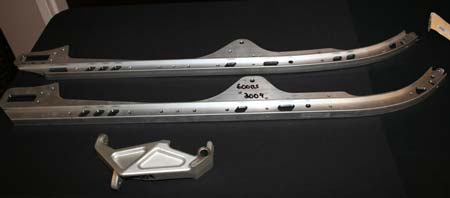 The new stronger 2009 slide rail, which has a revised profile, appears at the bottom while last year’s slide rail appears at the top of the photo.
The new stronger 2009 slide rail, which has a revised profile, appears at the bottom while last year’s slide rail appears at the top of the photo.But the crew didn’t stop there. The rear skid offers new rear arm geometry and a stronger shock linkage that should allow racers to find suitable valving and spring setups for a particular track. And it should provide bettering tracking through the bumps. Slide rails are stronger for improved durability and the revised profile is said to improve cornering and braking. A four idler wheel rear axle helps maintain track alignment and prevent derailing. Like the front suspension, the rear receives new C-40 racing clicker shocks with 16mm shock shafts that feature external high-and-low-speed compression damping adjustment. A new softer durometer, much more durable single ply track wraps around the suspension.
Strong & Balanced
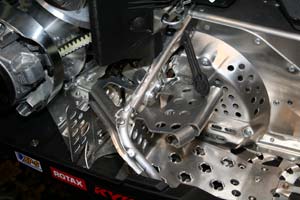 The new sled features a new footrest, toehold and stronger brackets for greater strength and comfort.
The new sled features a new footrest, toehold and stronger brackets for greater strength and comfort.A race sled must have a strong and balanced chassis in order to deliver power to the snow and maximize suspension performance. To hold up under the extreme conditions of snocross, new stronger castings, engine supports and a pipe support grace the sled. But a few of the most visible changes are the new wider, stronger running boards with a support extrusion. In addition, the integrated footrest, brackets, and toehold should not only provide better rider comfort but better chassis support.
Some other important changes include a new Brembo brake caliper that improves heat transfer through the casting to maintain maximum pressure and avoid boiling the fluid.
There’s also new calibration for the secondary and primary clutches. Both drive axle and jackshaft receive a new welding process to enhance strength.
Race School Instruction
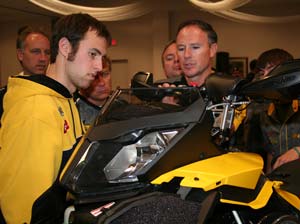 Chief instructor Greg Goodwin shows the assembled group of racers how to use the gauge pack for acquiring two minutes of data.
Chief instructor Greg Goodwin shows the assembled group of racers how to use the gauge pack for acquiring two minutes of data. 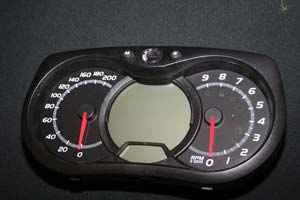 The new gauge pack features data acquisition capability so the racers can easily measure on track performance.
The new gauge pack features data acquisition capability so the racers can easily measure on track performance.During the day, Greg Goodwin covered each area of tuning and setup, which included engine, clutching, drivetrain, suspension, data acquisition, and chassis. The former oval racer, now snocross race sled tuner for his son, dedicated time to discussing the importance of acquiring the proper race fuel. Goodwin recommended racers use 94 octane straight gas (no ethanol) from a sealed fuel container to eliminate the possibility of fuel contamination. These fuel containers or drums are available from most major petroleum companies. If ethanol is inadvertently used, or if octane falls below 92, the engine will not produce peak performance, and this could lead to predetonation and possibly engine seizure. Later on, Goodwin and the crew explained how to set the correct throttle position for proper ECU operation and how to use the gauge pack for two minutes of continuous data logging. In addition, he explained how to use the “holeshot button” to warm the pipe without heat soaking the engine and, thus, degrading the power output.
As with any form of racing, proper clutch setup is essential. Ski-Doo race school instructor Goodwin discussed the basics of clutching, available ramps, springs, and roller pin considerations to get the best setup for a particular track. He also covered the finer points of secondary clutch tuning and how to figure out the ideal helix angle and spring for a particular set of conditions. Shock rebuilding and valving was discussed in detail with special focus on how to purge the shocks of air bubbles to reduce the possibility of shock fade.








 Your Privacy Choices
Your Privacy Choices